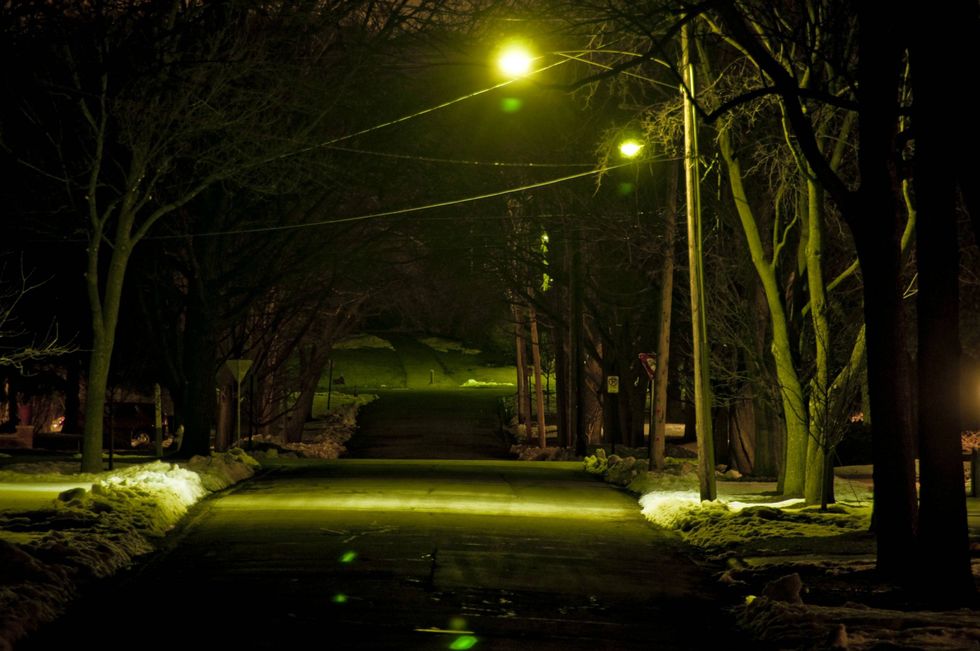College. You spend years anticipating the day you walk through those hallowed (and bloody expensive) halls—but are they as safe as they seem? Documentaries like Kirby Dick's "The Hunting Ground" and Todd Philip's "Frat House" have previously exposed the dark side of the college experience, documenting the prevalence of sexual assault and hazing.
But what happens when that darkness is taken to the ultimate extreme? Here are 4 truly terrifying unsolved murder mysteries that have occurred on college campuses. Please remember the buddy system, students.
4. Arlis Perry
Arlis Perry was a 19-year-old, newlywed student at Stanford University who was found brutally murdered in the Stanford Memorial Church on October 12th, 1955. She had been stripped naked and had been sexually assaulted with a candlestick, another found resting between her breasts. Semen was strewn about the pew underneath which she was discovered. The mortal wound was a blow to the head with an icepick that the killer left protruding from her skull.
On the night of her murder, Arlis got in a small argument with her husband, Bruce Perry, and decided to go to the church for a few moments of prayer an contemplation. A security guard locked the doors to the church there afterwards, believing Arlis had left the vicinity, but the next morning, the grizzly scene sent shockwaves through campus.
Though a handprint had been found on the candle that was used to assault Arlis, no one was ever matched to it. The security guard on duty reported seeing seven people enter the church that night at different times. Six people were identified and cleared of suspicion, but the seventh—most likely the murderer—was never identified.
This case took a dark turn in 1979 when David Berkowitz, New York's infamous "Son of Sam" serial killer, mailed the police a book about Satanism and witchcraft practiced in the Process Church. In the margins, he had written: "Arliss [sic] Perry. Hunted, Stalked, and Slain. Followed to Calif. Stanford University."
While behind bars, Berkowitz admitted to joining a satanic cult that murdered innocent people in order to fulfill a ritual, and said that Arlis was one of the victims murdered by the same organization, though definitive proof was never ascertained.
More recently, in June of 2016, a man by the name of Brian McCraken confided to police that he had visited the church on the night of Arlis' murder and had happened upon an incredible scene. He described it as so in the New York Post:
“This guy is up at the lectern, a young skinny white guy and he has an afro wig on, a light-colored large afro wig, looked very striking, and he's playing a flute, a large silver flute. To the right of him on the altar was this nude girl lying on the altar. She has candlesticks burning, one on either side of her…. I had the feeling there was no danger to the girl. It didn't look serious. The girl looked comfortable."
In the 1950's, as McCraken described, occult-style games and sex acts were quite popular among college students, so he thought little of the incident; but, after hearing about the murder later on, he kept silent for fear of accusation. McCraken was subsequently shown photos of the remaining suspects in the case and, in a shocking development, he jumped out of his seat when he saw who he recognized as the flautist's face, a man who had been in Stanford's marching band. Despite the ID, police cleared the man identified to be the mysterious flute player for lack of any evidence or connection to the incident. Arlis' murder still remains unsolved.
3. Jack Davis Jr.
Jack Davis Jr., a 20-year-old student at Indiana University of Pennsylvania, was discovered deceased the evening of October 16th, 1987, at the bottom of an exterior stairwell of Weyandt Hall, IUP's life science building.
The coroner ruled the cause of death as "asphyxiation." According to official reports, Jack was heavily intoxicated at a fraternity party the night of his death and had tripped down the stairs, ultimately dying by choking on his own vomit. His body was discovered five days later.
Although the official reports ruled Jack's death an accident caused by intoxication, Jack's parents were not convinced. If Jack truly had died that night, they raised, then how come it took students five days to find his body at the bottom of a public stairwell visible from at least one classroom in the science building?
The parents decided to order a personal autopsy and investigation, and the results were shocking. According to the autopsy, Jack had a blood alcohol level of 0.0 when he died—he was completely sober. Eyewitnesses at the party Jack attended the night he passed said that he was drinking heavily and was visibly intoxicated, meaning that Jack had to have been alive at least an additional 30 hours than previously speculated, enough for his blood alcohol level to reach zero.
Other pieces of evidence added skepticism to the original reports. The official report said that Jack choked on his own vomit, but, strangely, no food particles were found lodged in his lungs. This means asphyxiation via vomit was impossible. Additionally, Jack had been clean shaven the night of the party; but, when his body was discovered, there was visible stubble on his face, reinforcing the notion that Jack had been alive longer than initially reported. Moreover, the night of the party and the following day, it had rained, but when he was found, Jack's clothes were bone-dry.
The most damning pieces of evidence were the three fracture marks on Jack's skull. Originally left out of the official report, the fractures were then attributed to Jack's supposed fall down the stairs. However, the type of fractures on the skull were not consistent with the egg-shell pattern seen on the skulls of fall victims. This evidence suggests that Jack had not died that night on the stairwell, but instead had died elsewhere and had been placed there at the bottom of the stairs five days later.
According to students interviewed, Jack belonged to a shady fraternity that most on campus though ill of. Jack's fraternity big brother was allegedly a cocaine dealer, and Jack's body was found wearing his brother's fraternity jacket. This lead some to believe that this was this a case of mistaken identity, that someone wanting revenge for a bad deal had mistaken Jack for his big brother and offed him. It has never been said for sure.
What struck many as most bizarre was the completely inaccurate original autopsy. It was nowhere close to correct, so much so it borders a cover-up story. Who needed protection? Who was so important that they needed a far-fetched story of accidental death to spare then suspicion?
The final twist to the story comes from an unidentified man interviewed a few years ago who claimed to have been a friend of the victim. He said that he believed that whatever transpired the night Jack died was no accident. He recounted a moment a week before Jack's death when he had mysteriously asked for "protection." But Jack died before his friend knew what Jack meant by this. The truth of Jack's death still remains a mystery.
2. Suzanne Jovin
Suzanne Jovin, a 21-year-old senior at Yale University, was found brutally murdered on the side of the road only two miles away from campus in 1998. She had been stabbed 17 times and her throat had been slit.
On the night of her murder, Suzanne emailed a friend of hers in German, saying that she would leave some books for her in the foyer of her apartment building. After this, she decided to return a borrowed car to a rental lot. She was walking back to her apartment when it is presumed that she entered a vehicle, either willingly or unwillingly. She was later found by a passerby bleeding profusely on the sidewalk. She was then rushed to the New Haven Hospital, but pronounced dead. Despite having her throat slit and being stabbed multiple times, the cause of death was a single (and presumably the final) stab wound, in which the broken-off tip of the murder weapon was lodged in her skull.
The only evidence collected from the scene was some DNA found under Susanne's fingernails and Suzanne's fingerprints along with an unknown palm print on a Fresca bottle found in the bushes nearby. The DNA and palm print, however, have never been matched to a suspect.
The first person of interest was Susanne's thesis advisor, James Van de Velde, who was supposedly having an affair with Suzanne at the time. However, a witness at the scene who claimed to have seen the murderer running from the direction of Suzanne's body told police that Van de Velde was not the man.
Because of the unusual nature of her murder, very few suspects ever surfaced. The only other person of interest was the unidentified German-speaking friend whom Suzanne lent her books to. In the email, Suzanne gave the friend the access code to her apartment building, and the books were gone when the police arrived to investigate her home. The friend was never identified and the books were never returned. If this person had been involved in Suzanne's murder, it is likely that this case will remain cold.
1. Betsy Aardsma
The final and most famous case involves a 22-year-old graduate student named Betsy Aardsma who was fatally stabbed in the heart in the stacks of the Pattee Library at Pennsylvania State University in 1969.
On the day of her murder, Betsy, in her first year of graduate school studying English, and a friend of hers decided to go to the library to collect research for a large paper she had to write. While Betsy was retrieving a book from the stacks, she was inexplicably stabbed by an unknown person who fled the scene immediately after. Though there were many people in the stacks at the time, Betsy surprisingly did not scream; additionally, she had been wearing a red dress, so her blood was not easily visible from a distance.
When students finally found her on the floor, they believed she was having a stroke and took her to the school's medical facility where she was pronounced dead.
Betsy had no known enemies and no suspects could be derived a study of her personal life. The only suspect was a mysterious man who, before Betsy was found on the floor, went to the clerk at the front desk of the library and said, cryptically, “Somebody better help that girl." The man then proceeded to exit the library and was never seen again. He has never been identified.
Some speculate that a man by the name of Richard C. Haefner, who was also a graduate student at Penn State, was the killer. Betsy had met Haefner socially a few times and had told relatives and friends that he gave her "the creeps." He was also known for carrying a knife on him. Haefner died in 2002 before any definitive investigation could be held. Betsy's murder still stands unsolved and, to this day, many at Penn State claim that her ghost haunts the stacks where she was murdered.




















